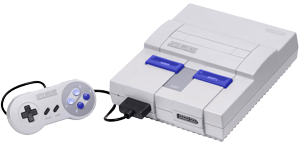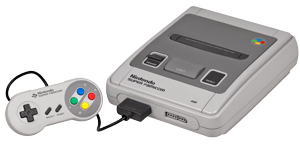Super Nintendo Entertainment System
 North American SNES North American SNES Japanese Super Famicom Japanese Super Famicom | |
| Manufacturer | Nintendo |
| Generation | Fourth generation |
| Retail availability | JP November 21, 1990 NA August 23, 1991 EU April 11, 1992 AUS July 3, 1992 |
| Discontinued | NA 1999 JP September, 2003 |
| Units sold | 49.10 million |
| Media | ROM cartridge |
| CPU | 3.58MHz 65c816 Ricoh 5A22 16-bit processor |
| Online services | Satellaview (Japan only), XBAND, Nintendo Power (Japan Only) |
| Best-selling game | Super Mario World (pack-in), 20.60 million Donkey Kong Country (pack-in), 9 million |
| Predecessor | Nintendo Entertainment System |
| Successor | Nintendo 64 |
The Super Nintendo Entertainment System (also known as the Super NES, SNES or Super Nintendo) is a 16-bit video game console that was released by Nintendo in North America, Europe, Australasia (Oceania), and South America between 1990 and 1993. In Japan and Southeast Asia, the system is called the Super Famicom (スーパーファミコン) or SFC for short, officially adopting the abbreviated name of its predecessor, the Family Computer. In South Korea, it is known as the Super Comboy (슈퍼 컴보이) and was distributed by Hyundai Electronics. Although each version is essentially the same, several forms of regional lockout prevent the different versions from being compatible with one another.
The Super Nintendo Entertainment System was Nintendo's second home console, following the Nintendo Entertainment System (NES). The console introduced advanced graphics and sound capabilities compared with other consoles at the time. Additionally, development of a variety of enhancement chips (which were integrated on game circuit boards) helped to keep it competitive in the marketplace.
The SNES was a global success, becoming the best-selling console of the fourth generation era despite its relatively late start and the fierce competition it faced in North America from Sega's Genesis/Mega Drive console. The SNES remained popular well into the 32-bit era, and although Nintendo has dropped all support for the console, it continues to be popular among fans, collectors, retro gamers, and emulation enthusiasts, some of whom are still making homebrew ROM images.
The SNES sold 49.10 million units worldwide. It was discontinued in 1999-2002 well after the launch of it's successor, the Nintendo 64.
Problems that may occur with any Super NES title on Dolphin are listed below.
Glitched Sound
Sound is glitched in the OpenAL backend. Use XAudio2 to prevent this. Fixed in 5.0-798.
Virtual Console Compatibility List (Super NES)
Help complete the list!
- Click the icon
 to the right of the rating stars and put just a number 1 through 5 into the page. Use the compatibility guide below as a reference of what rating to use.
to the right of the rating stars and put just a number 1 through 5 into the page. Use the compatibility guide below as a reference of what rating to use. - When updating a rating, please make sure it's in accordance with the list of problems in the title's page.
| Region indicator | Region description |
|---|---|
| AU | Australia |
| CA | Canada (NTSC /w French translation) |
| EU | Europe, PAL/SECAM territories |
| JP | Japan and Asia (NTSC-J) |
| KO | Korea |
| NA | North America and NTSC territories |
| RU | Russia |